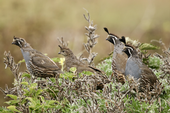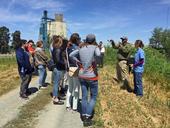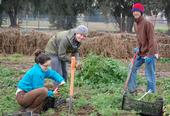- Author: Kat Kerlin, UC Davis

Natural habitat maximizes the benefits of birds for farmers, food safety and conservation
A supportive environment can bring out the best in an individual — even for a bird.
After an E.coli outbreak in 2006 devastated the spinach industry, farmers were pressured to remove natural habitat to keep wildlife — and the foodborne pathogens they can sometimes carry — from visiting crops. A study published today from the University of California, Davis, shows that farms with surrounding natural habitat experience the most benefits from birds, including less crop damage and lower food-safety risks.
- Author: Mike Hsu

A farm-edge hedgerow can be more than a boundary or barrier. When it comprises blue elderberry, it can be a way to integrate biodiversity in an often-simplified agricultural landscape – and connect with a legacy of stewardship and use by California's Native peoples.
A new guide, published by UC Agriculture and Natural Resources, provides detailed instructions and advice for California farmers on growing, harvesting and marketing blue elderberry. It is available as a free download in the UC ANR catalog at
- Author: Pamela Kan-Rice

UC Global Food Initiative student fellows from University of California campuses throughout the state gathered for a springtime field trip in the Central Valley to learn more about the relationships between food, farming and the environment.
The day-long tour, hosted by UC Agriculture and Natural Resources, began at a farm that is maintained to support wildlife in the breezy Sacramento-San Joaquin River delta region. The GFI fellows also viewed a habitat restoration project at LangeTwins Winery then watched freshly harvested cherries being processed at Morada Produce's packing plant. They wrapped up the day with a tour...
- Author: Diane Nelson

Pop quiz: About 7 billion people live on earth today, and that number is expected to hit 9 billion by 2050. That’s a lot of mouths to feed. What’s the best way to reform our global food production to meet the rising demand?
- Invest in technology, plant breeding, soil science and seed genetics to make our finite farm land more productive.
- Increase sustainability, so farm land can remain productive in the future.
- Encourage more people to get into farming.
- Help farmers manage climate change, water supply and pest control.
- All of the above and a whole lot more.
Yep, the answer is e. All of the above and a whole lot more. Many of the challenges...
- Author: Ann Brody Guy

Adapted from an article by Eileen Ecklund in Breakthroughs magazine.
Scaling up — that’s always the sticking point with organic farming when it faces the question of whether it can feed the world’s hungry millions.
But a group of UC Berkeley scientists say that continuing on our current path of industrial agriculture is simply not sustainable, given its enormous water, energy and chemical inputs, together with the new challenges posed by climate change, such as temperature and precipitation extremes.
With the launch of the interdisciplinary



